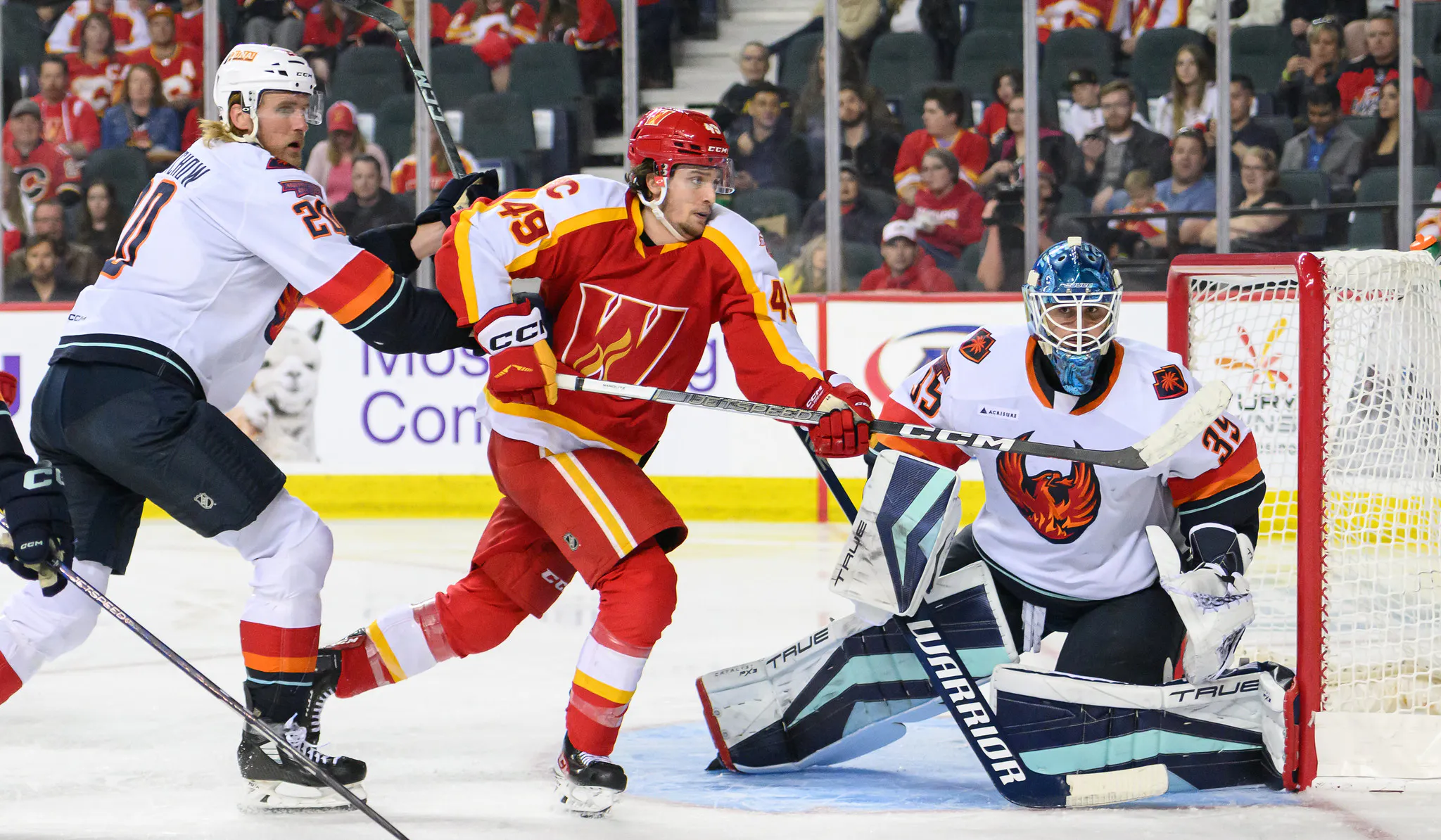Nation Sites
The Nation Network
FlamesNation has no direct affiliation to the Calgary Flames, Calgary Sports and Entertainment, NHL, or NHLPA
The Calgary Flames’ development apparatus continues to grow

Photo credit: Angela Burger/Calgary Wranglers
Back in the day, hockey had a pretty narrow view of drafting and development. Players were selected in the entry draft and, once they were signed, they were sent to the minor league team. Maybe they’d progress between being drafted and going joining the farm team, maybe they wouldn’t. A lot was dependent on the team’s scouts drafting well.
The introduction of the salary cap changed everything, and there’s no better club to exemplify those changes than the Calgary Flames.
In 2003-04, the Flames development system hit its nadir. It probably cost them the Stanley Cup.
The Flames didn’t have a dedicated farm team in 2003-04, instead placing a few players with the American Hockey League’s Lowell Lock Monsters, the Carolina Hurricanes’ farm team. The Flames were limited to assigning one goaltender and eight skaters to Lowell, with the Hurricanes providing the remainder of the roster… and the coaching staff.
In no small part due to that arrangement, the Flames ended up dressing Brennan Evans for two playoff games. Their system was so thin that a player who entered 2003-04 with zero pro games was their best available option at one point during the Stanley Cup playoffs.
Since 2005, the Flames have had a dedicated farm team. Their AHL clubs have roamed around the continent a little bit over the past two decades:
- Omaha, Nebraska (2005-07) as the Omaha Ak-Sar-Ben Knights
- Moline, Illinois (2007-09) as the Quad City Flames
- Abbotsford, British Columbia (2009-14) as the Abbotsford Heat
- Glens Falls, New York (2014-15) as the Adirondack Flames
- Stockton, California (2015-22) as the Stockton Heat
Part of the logic behind the AHL’s move west – swapping some west coast ECHL franchises for some east coast AHL franchises to create a Pacific Division – was co-locating a bunch of teams in and around California to minimize travel and maximize practice days and developmental opportunities. The move also coincided with the Flames investing in additional resources for the farm team, including additional full-time coaches and staff.
During the 2020-21 pandemic season, the limitation of travel across the US/Canada border led to the AHL instituting a Canadian division for that season. The Flames’ farm club, usually in Stockton, spent the year in Calgary (albeit operating as the Stockton Heat). But the Flames found a ton of value-adds in having the farm team located in the same building as their NHL parent, leading to the Flames moving the Heat to Calgary fully in 2022 and rechristening them the Wranglers.
In addition to emphasizing the farm team more and more over the past several seasons, the Flames have also added more to the club’s developmental apparatus. When Brad Treliving arrived in 2014, the club had a pair of directors of player development (Ron Sutter and Troy Crowder) and skills coach Domenic Pittis. As the 2023-24 season begins, the Flames’ club directory reflects a director of player development (Ray Edwards), a skills coach (Darren Rommerdahl), a skating coach (Danielle Fujita), three development coaches (Martin Gelinas, Michael Stone and Rebecca Johnston), a development strength coach (Zach McClean) and a mental performance coach (Matt Brown).
In addition to the developmental staff, the Flames have also built out a pretty fulsome staff for the Wranglers – including two assistant coaches and dedicated video and strength coaches – and their data systems are mature enough that can provide data and video for their prospects and minor league players, too.
Why have the Flames invested in all these resources? They’re trying to gain a competitive edge. In a salary cap environment, teams are on a level playing field financially… but it gives teams that can get value out of their entry-level players, who are making the least of all their players, a big advantage. That’s been doubly true over the past few seasons, as the financial impacts of the pandemic have led to a nearly flat cap with very little growth over the past few seasons.
The Flames have been a pretty effective organization over the past several seasons at drafting and development. Many of their draft picks have gone pro and provided the team with value at the AHL level. Several have graduated from the farm system and become productive NHLers, including Dillon Dube, Oliver Kylington, Andrew Mangiapane and Rasmus Andersson. Part of the credit deservedly goes to the Flames’ scouting staff for finding talented players, but don’t discount the impact of the people that make up their development apparatus in helping them get to the next level.
If the Flames want to get to where they want to go as an organization, they’ll need to continue to integrate youth into their lineup. For that to happen, they’ll need to keep seeing results from their drafting and development staff.
Breaking News
- Flames Prospect Roundup: How the standings shape up entering the holiday break
- NHL Notebook: Sidney Crosby takes sole possession of most points in Penguins’ franchise history
- FlamesNation Mailbag: Waiting for Santa with reader questions
- Flames injury news: positive signs for Martin Pospisil
- Recap: Martin Frk leads Wranglers to memorable Winter Wranglerfest win in more ways than one
